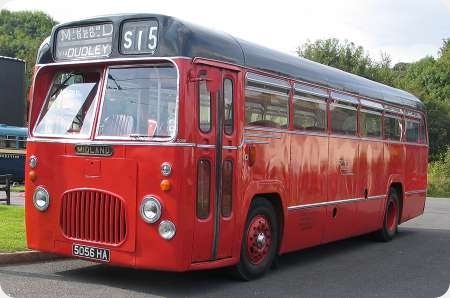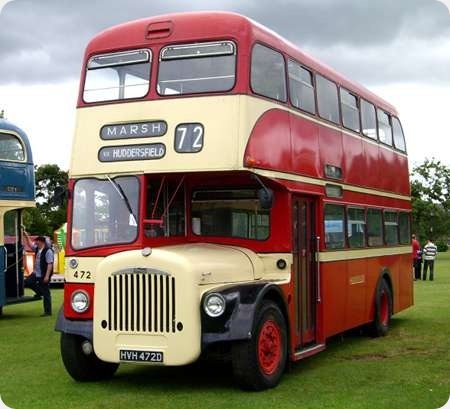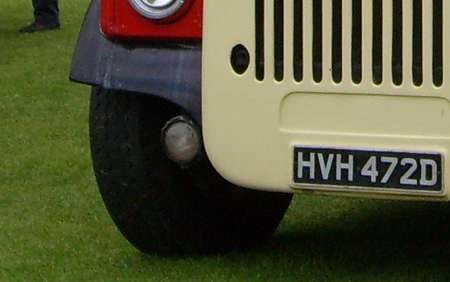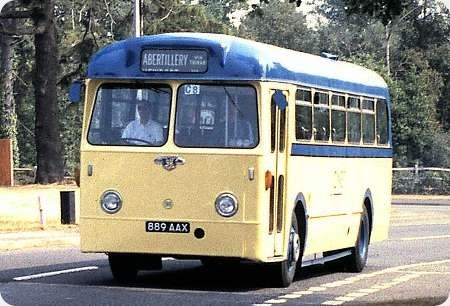Midland Red – BMMO S15 – 5056 HA – 5056
Midland Red (Birmingham & Midland Motor Omnibus Co)
1962
BMMO S15
BMMO DP40F
This was one of the second batch of S15s. Broadly similar to the S14 bus, these were designed as dual-purpose vehicles and featured bucket-seats and double rear wheels as well as, on this second batch, some chrome trim. Circa 1969 the batch was relegated to bus work after being repainted into the standard bus livery. While dual-purpose they had black roofs. In this shot 5056 is seen at the Black Country Living Museum in September 2014.
Photograph and Copy contributed by Les Dickinson
25/06/15 – 06:46
I recall 5048 HA (allocated, I think, to Coalville depot) as a regular performer on the Birmingham – Nottingham route X99 in the 1960s. Those bucket seats were pretty comfortable.
Stephen Ford
25/06/15 – 13:34
There’s something in the ‘copy’ which intrigues me, Les, and thanks for posting. There is mention of double rear wheels as if this is something of an innovation. Given the company’s leadership in so many aspects of bus design and operation, were these really the first Midland Reds to have twin wheels at the rear?
Pete Davies
26/06/15 – 05:22
Peter, As I understand it, most of the S14 class were fitted with single rear wheels as part of a desire to produce a light-weight vehicle. Unladen weight was not much over five tons according to M.W. Greenwood’s excellent book – ‘Midland Red Buses’. The S15 was a further development of the class but with modifications, including twin rears, to produce a dual-purpose vehicle.
Les Dickinson
26/06/15 – 05:23
I am no expert on Midland Red, but I suspect that the S14 had single rear wheels as an experiment. Both AEC and Leyland tried this with their underfloor-engined buses, but found that road holding suffered.
David Wragg
26/06/15 – 05:24
I think what Les meant to convey was the fact that the previous S14, built to a lightweight design, had single rear wheels.
Nigel Edwards
27/06/15 – 06:42
Nigel is quite correct regarding single rear wheels on the S14. Although I drove S15s in service (5050, 5055 and 5073 (now preserved)), I never had chance to drive an S14 so I can’t comment on their road holding.
Larry B
27/06/15 – 06:43
Thank you for filling this gap in my knowledge of Midland Red.
Pete Davies
28/06/15 – 05:54
There are 2 S15 in preservation but this one is the only one with original DP seats. It has also been retro-fitted with the 10.5 litre engine. The driving position is not comfortable and requires some getting used to given a tight cab and upright pedals. I sold it after getting a left knee problem and so did the previous owner for the same reason. It is really fast on the road and my claim to fame is 2hrs 40mins from Gateshead to Digbeth some 4 years ago after a Bus Rally.
Roger Burdett
25/12/15 – 07:54
I conducted this bus 5056 HA in 1968 and 1969 when I worked my student holidays at the Coalville garage
Wayne Robinson
26/12/15 – 06:56
Roger B- I’ve just seen reference to your record breaking run from Gateshead to Digbeth. Were you trying to recreate the glorious days of the Midland Red Motorway Expresses? Don’t let the rozzers read this, but it would mean an average speed of at least 75 mph start to finish!
Paul Haywood
27/12/15 – 09:02
Paul
In hindsight I probably meant 3hrs 40mins. It certainly was a fast trip but we would not have gone over 70. The vehicle is geared for 75 with the gearbox/engine combination.
Roger Burdett
29/12/15 – 10:46
I was ‘taken for a ride’ on the top deck of Roger’s beautiful D9 (5424) around Bewdley at a Meet. I can vouch for his spirited handling and was treated to his own version of the "tilt test"!, afterwards speaking to him he did say "I drive like a bus driver", long may he do so.
Nigel Edwards
30/12/15 – 06:27
I travelled from home from school at Godalming to Guildford back in the ’50s and remember a couple of occasions when a bunch of us managed to get down the hill in time for an earlier bus than the usual one, we all piled up stairs but by the time we were leaving Farncombe the conductor had to come up and tell us to get down stairs because there was an insufficient number of passengers downstairs so the weight in the bus was to high for stability.
He probably didn’t use those exact words but the meaning was clear.
John Lomas
01/01/16 – 11:33
The conclusion submitted by Larry B (above 27/06/15) is quite correct as my memory of working at Redditch Garage in 1968 includes one morning with an S14, in the snow on the hilly terrain the only way to make progress was to place the rear wheels in the gutter and "sidewall" the bus along. The S14 was notorious for poor rear holding even in wet weather.
Tony Morgan
23/05/22 – 06:01
Re the BMMO S14 & S15 (speaking as a former BMMO engineer) the S15 was a slightly modified dual purpose version of the S14 and this included twin rear wheels. There is no suggestion that these were the ‘first BMMO vehicles with twin rear wheels’ as the company had been building buses since 1923 and up till the monocoque generation they had a normal chassis and yes, twin rear wheels. The S14 however was designed with light weight in mind even to the point of single rears on many (miscellaneous) examples and it was so light it was bouncy and rattily but also very light on fuel. However it lent itself to early OMO operation with various cab layouts being tried out,both open and fully enclosed although it didn’t cope well with the rough Leicestershire country roads that these OMOs ran on! Nevertheless many S14’s including OMOs retained their single rears to the end around 1971 and one such was 4714. This feature enabled you to stand in the pit and change the rear pads without removing the wheel! Yes they did slide on wet roads. But they were running almost empty as it was a railway replacement route, the 697 along the route of the former Nuneaton to Ashby/Burton line that had closed to passenger service from 1931 to closure in 1971.
Michael Hunt





